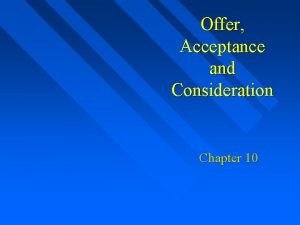Offer and Acceptance More detail on the special






- Slides: 6

Offer and Acceptance More detail on the special study cases For each slide you must write an evaluative paragraph, either criticising or justifying the decision in the case being discussed.

Hyde v Wrench Ratio – a counter offer is a rejection of the original offer, the original offer is no longer available. This was developed in Gibson v Manchester where they said a contract is made where an offer is unconditionally accepted. Evaluative points – this rule gets complicated in the battle of the forms where there may be many counter offers and no clear acceptance, however there may be a contract if there has been performance. See Trentham v Archital Luxfer. Also there may be confusion between a counter offer and a request for information – see Stevenson v Mc. Lean.

Felthouse v Bindley Ratio – silence isn’t an acceptance, there must be evidence of actual agreement for there to be a contract. This has been developed in the Distance Selling Regulations 1980 which forbid sending unsolicited goods to a consumer and then demanding payment (the goods become a gift). Evaluative points – is Felthouse a good decision? The nephew showed that he wanted to be in the contract because he instructed the auctioneer to withdraw the horse. Also the ratio above has many exceptions, e. g. where there has been a course of dealing between the parties.

Brinkibon v Stahag Stahl Ratio – a telex acceptance takes effect when it arrives, subject to sound business practice and the expectations of the parties. This was developed in Thomas v BPE Solicitors where an acceptance was effective at 6. 00 pm on Friday. This is the only case on emailed acceptance. Evaluation points – The SBP principle is sensible but vague and can make it very difficult to pin down a definite time of acceptance, this is important when comparing it to revocation. If a customer makes the offer and the trader accepts, the rule above means the contract is made where the customer lives. This could be difficult for online traders based in another country.

Henthorn v Fraser Ratio – the postal rule will apply where it must have been in the contemplation of the parties that it should be used. (A revocation was posted before the acceptance but arrived afterwards, so was ineffective. ) Evaluation points – it is not clear that it had been contemplated here because (1) the offer was made by hand, and (2) they had been given 14 days to accept. Gill Poole says that the postal rule is just a way to ensure certainty, and that whatever rule is adopted will end up being harsh on one party. Re Imperial Land Co of Marseilles (Harris’ Case) is much the same!

Household Fire and Accident Insurance Co v Grant Ratio – a letter accepting an offer to buy shares was sent but never arrived. There was a binding contract from the moment of posting. Evaluative points – In Grant LJ Bramwell was a dissenting judge. He said that the postal rule is arbitrary and it makes contract law random, depending on whether an acceptance is sent by hand, posted or emailed. Bramwell said the harm caused by the rule could only be avoided if all ‘prudent men’ excluded the rule when making an offer. Also there is no English authority on whether the acceptor cancel an acceptance once it’s in the post. Some authors say no because this would allow the acceptor to ‘play the market’ by sending an acceptance but then withdrawing it if market conditions change.










